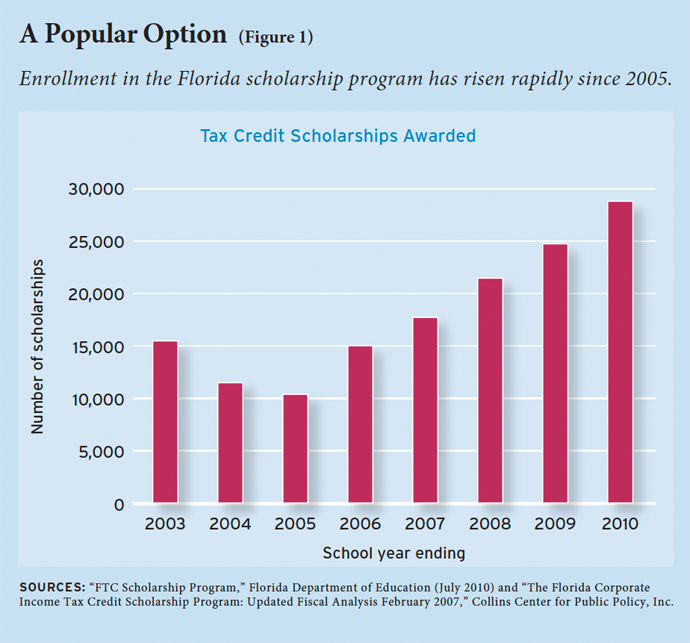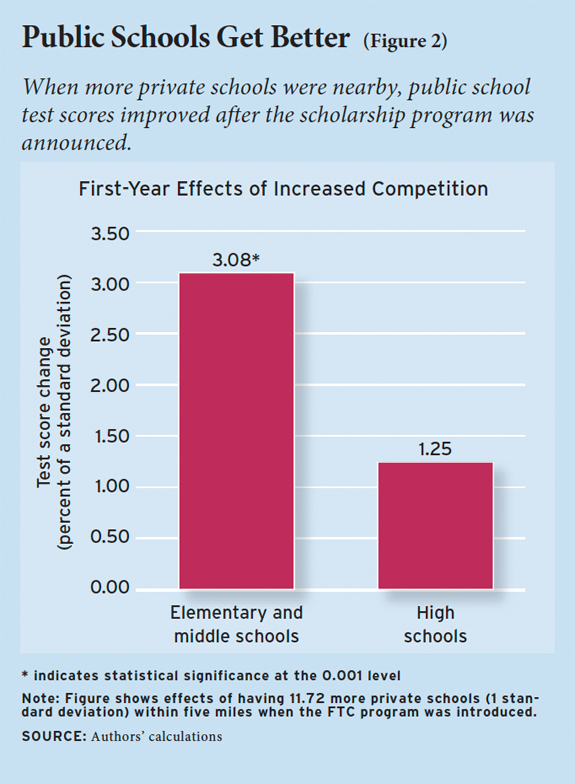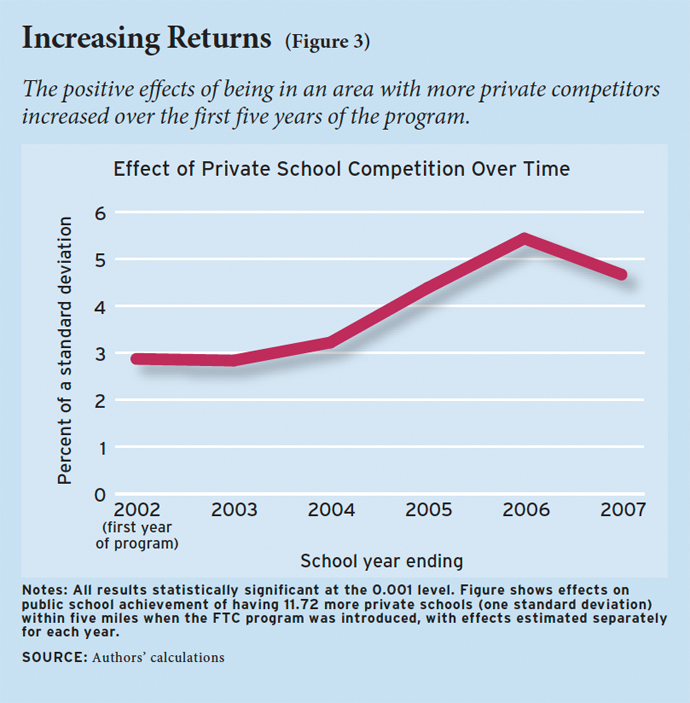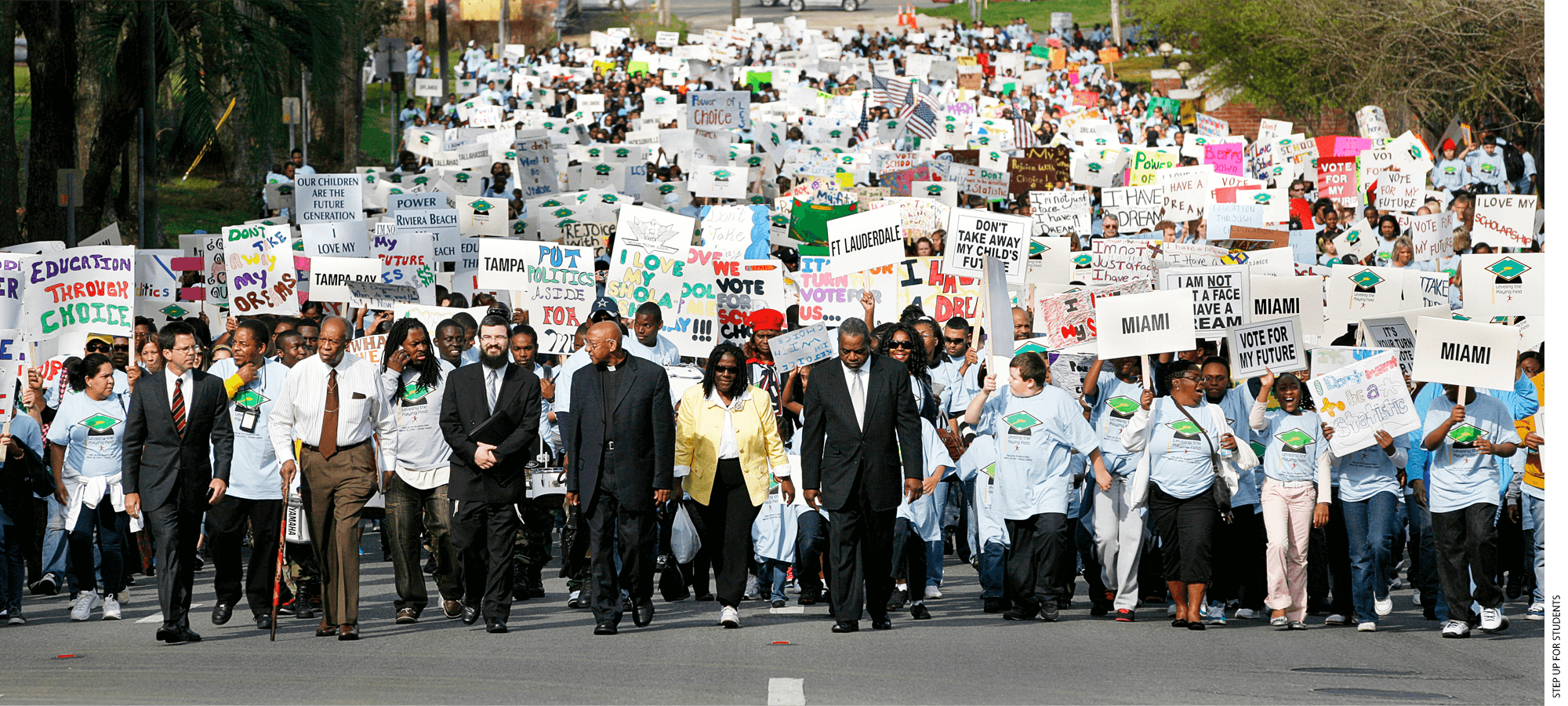An unabridged version of this article is available here.
Programs that enable students to attend private schools, including both vouchers and scholarships funded with tax credits, have become increasingly common in recent years. This study examines the impact of the nation’s largest private school scholarship program on the performance of students who remain in the public schools. The Florida Tax Credit Scholarship Program (FTC) was signed into law in 2001 and opened to students from low-income families in the 2002–03 school year. FTC provides corporations with tax credits for donations they make to scholarship funding organizations, the nonprofits that determine student eligibility for the program and issue scholarships. Corporations can receive dollar-for-dollar tax credits for up to 75 percent of their total state tax obligation each year.
Although little noticed, tax credit scholarship programs now send many more low-income students to private schools than do traditional school voucher programs. More than 104,000 students nationwide attended private schools through tax credit programs in the 2008–09 school year, while only 60,000 students used private school vouchers. Scholarship programs similar to Florida’s now operate in several states, including Arizona, Pennsylvania, Rhode Island, and Indiana, and are being considered in Maryland and New Jersey. The Florida program is set to expand dramatically in the coming years (see sidebar), making evidence of its consequences all the more timely.
Expanding Scholarship Opportunities
In April 2010, Florida governor Charlie Crist signed into law SB 2126, which expanded both funding and eligibility for the Florida Tax Credit Scholarship Program (FTC). Funding for the program had been capped at $118 million. Under the new rules, as much as $140 million in corporate tax liabilities and insurance premiums may be applied to the program in the 2011 budget year. If the scholarship program remains successful, the funding cap may rise by as much as 25 percent per year. The legislation also loosened the eligibility rules to include children from families with incomes up to 230 percent of the poverty level.
During the 2009–10 school, nearly 29,000 children attended more than 1,000 private schools across the state with FTC scholarships worth between $3,950 and $4,100. Three-quarters of participating students are black or Hispanic; 60 percent are from single-parent homes. With expanded access, the program could grow to include 70,000 students by 2015. The scholarship amount may increase to as much as 80 percent of the state’s per-pupil expenditure, currently $6,866, enabling many more families to afford private school tuition.
SB 2126 also increased accountability for participating private schools. The state had already required FTC scholarship students to participate in standardized testing using a nationally normed exam chosen by each private school; a study commissioned by the Florida Department of Education found that, in 2007–08, their academic gains were similar to students nationally across all income levels and to similar Florida students who remained in public schools. To make the latter comparison, the study compared program applicants who were barely eligible to those who had incomes just above the eligibility threshold. Under the new rules, private schools with 30 or more FTC scholarship students must release to the public gain scores on standardized tests for those students. The legislation expanding the FTC program passed both the House and Senate with strong bipartisan support.
One popular argument for expanding private school choice is that public schools will improve their own performance when faced with competition for students. Because state school funding is tied to student enrollment, losing students to private schools means losing revenue. The threat of losing students to private schools may give schools greater incentive to cultivate parental satisfaction by operating more efficiently and improving the outcomes valued by students and parents. Alternatively, private school vouchers and scholarships may have unintended negative effects on public schools: they may draw away the most involved families from public schools, community monitoring of those schools may diminish, and schools may reduce the effort they put into educating students.
It is notoriously difficult to gauge the competitive effects of private schools on public school performance. Private schools may be disproportionately located in communities with low-quality public schools, causing the relationship between private school competition and public school performance to appear weaker than it actually is. If, however, private schools are located in areas where citizens care a lot about educational quality, the relationship will appear stronger than it truly is.
This study takes advantage of the introduction of the FTC to provide new evidence on the effects of increased competition on student achievement in public schools. Before the program began in 2002, roughly 11 percent of students in Florida were enrolled in private schools. FTC targeted students from low-income families, only 5 percent of whom had been attending private schools.
We examine whether students in schools that face a greater threat of losing students to private schools as a result of the introduction of tax-credit funded scholarships improve their test scores more than do students in schools that face less-pronounced threats. We find that they do, and that this improvement occurs before any students have actually used a scholarship to switch schools. In other words, it occurs from the threat of competition alone.
Florida Tax Credit Scholarship Program
In order to be eligible for an FTC scholarship, students must meet the income guidelines (until recently, family incomes below 185 percent of the federal poverty line for new applicants) and either must have attended a Florida public school for the full school year before program entry or be entering kindergarten or first grade. With the exception of these early-grade private school students, students already attending private schools in Florida are not eligible for first-time scholarships. Students who enter a private school on a scholarship are eligible to retain their scholarships in future years, so long as their family income remains within the stated limits (until recent changes, below 200 percent of the federal poverty line).

Scholarships need not cover all of the costs of attending private schools, and parents are free to send their children to any private school regardless of the share of tuition and fees the scholarship covers. The scholarship is quite generous; it covers approximately 90 percent of tuition and fees at a typical religious elementary school in Florida and two-thirds of tuition and fees at a typical religious high school. As a result, the program greatly increased the accessibility of private schools to low-income families. In the first year, some 15,585 scholarships were awarded, increasing the number of low-income students attending private schools by more than 50 percent. For the 2009–10 school year, the FTC program awarded scholarships to 28,927 students (see Figure 1).
Data
Our analysis draws on several data sources. The Florida Department of Education’s Education Data Warehouse provides test scores from the Florida Comprehensive Achievement Test (FCAT) and demographic characteristics for all students in the public schools. We use test-score data from the 1999–2000 school year through 2006–07. Students classified as learning disabled were excluded from the analysis, as they are eligible for a more generous voucher through the McKay Scholarship Program, and the FTC program should therefore have had no effect on schools’ efforts to retain these students (see “The Case for Special Education Vouchers,” features, Winter 2010).
The Florida Department of Education publishes public and private school addresses, including latitude and longitude information for the public schools. The address information was geocoded to generate measures of the pressure that public schools face from private competitors. We first limited our attention to the 92 percent of public school students in the state attending schools with a private competitor within a five-mile radius. Because it is not obvious how best to gauge the amount of competition faced by the remaining schools, we constructed four different measures:
• Distance: the crow’s-flight distance between the physical addresses of each public school and the nearest private competitor. A private school qualifies as a competitor to a public school if it serves any of the grades taught in that public school.
• Density: the number of private competitors within a five-mile radius of the public school.
• Diversity: the number of different types of private schools within a five-mile radius of the public school. To generate this measure, we first identified 10 distinct types of private schools, defined by their stated religious (or secular) affiliation.
• Concentration: an index of how varied the private school competitors are for a given public school, based on the counts of different types of schools within a five-mile radius.
The distance and density measures gauge whether easier access to a private school of any type increased the competitive pressure on public schools when the new policy lowered the effective cost of attending private school for eligible students. The diversity and concentration measures capture the variety of options available to students; public schools in areas with more varied options should feel more competitive pressure in the wake of the policy change.
Methods
In order to determine the effect of scholarship-induced private school competition on public school performance, we examine whether students in schools that face a greater threat of losing students to private schools as a result of the introduction of tax-credit funded scholarships improve their test scores more than do students in schools that face a less-pronounced threat. Specifically, we look to see whether test scores showed greater improvement in the wake of the new policy for students attending public schools with more (or more varied) nearby private options that suddenly became more affordable for low-income students than did scores for students attending schools with fewer (or less varied) potential competitors.
This analysis is possible because of the considerable variation in potential competition faced by schools across the state of Florida. Prior to the introduction of the program, some communities in Florida had a much richer and more diverse set of private school options than did other communities. The overall share of low-income students attending private schools ranged from 1.4 percent in Punta Gorda to 7.9 percent in the Melbourne-Titusville-Cocoa-Palm Bay area. More importantly, by our measures, the amount of competition that specific public schools faced on the eve of the program also varied widely. Our density measure, for example, ranges from one private school within five miles to 60. The average Florida public school had roughly 14 private schools nearby, but more than 30 percent of schools had fewer than 2 or more than 30.
We isolate the effect of competition introduced by the program by comparing the performance of each school’s students to the performance of its students the year before the program was enacted. When making these comparisons, we take into account student characteristics that are associated with test scores, including gender and race/ethnicity, English-language-learner status, and eligibility for free or reduced-price lunch.
We also control for some characteristics of schools that could affect the degree of competitive pressure. Most importantly, we control for the letter grades that schools received from the state’s accountability system; schools with lower grades may feel particular pressure to increase their scores to avoid accountability sanctions, independent of the effects of the FTC program. We also control for the percentage of the school’s student body that was eligible for free or reduced-price lunch, as only these students were eligible for FTC scholarships.
There are three main ways in which a program that expands access to private schools could affect public school performance. Public schools could react to private school competition by altering their policies, practices, or effort; this is the direct competitive effect. Such a program could also affect public schools by changing the mix of students who attend them. A third possibility is that, so long as only a few students leave a public school with scholarships, the program could have effects on resources. Resource effects could be either negative (as total state aid decreases with the loss of students), or positive (as per-pupil resources might actually increase following small losses of students, due to the indivisibility of classroom teachers). We can eliminate the possibility of student-body composition and resource effects by concentrating solely on the FTC program’s effects during the 2001–02 school year, after the program’s announcement but before students could actually leave the public schools with a scholarship. During this academic year, students in the public schools were applying for private school scholarships for the following year.
Results
We find that all four measures of competition (distance, density, diversity, and concentration) are positively related to student performance on state math and reading tests. (Because we obtained similar results looking at performance in each subject separately, we focus our discussion on the average score across both subjects.) Each of our competition measures uses different units. We therefore report the estimated effects of a one standard deviation increase in the amount of competition faced by a given public school by each measure.
For every 1.1 miles closer to the nearest private school, public school math and reading performance increases by 1.5 percent of a standard deviation in the first year following the announcement of the scholarship program. Likewise, having 12 additional private schools nearby boosts public school test scores by almost 3 percent of a standard deviation. The presence of two additional types of private schools nearby raises test scores by about 2 percent of a standard deviation. Finally, an increase of one standard deviation in the concentration of private schools nearby is associated with an increase of about 1 percent of a standard deviation in test scores.
Although these effects are relatively small, they consistently indicate a positive relationship between private school competition and student performance in the public schools, even before any students leave for the private sector. That is, these results provide evidence that public schools responded to the increased threat of losing students to the private schools. The fact that we obtain quite similar results regardless of the specific measure used makes us confident that the findings are not driven by other factors that might distinguish public schools facing more or less competition based on a given measure. Indeed, in ongoing work we have also considered measures of competition based on the number of available slots in nearby private schools and on the number of nearby churches, and again find very similar results.
Moreover, it is important to recognize that the results reported above represent lower-bound estimates of the effects of competition on public school performance. They are based only on comparisons of schools with different levels of competition. If all public schools improved their performance in response to the scholarship program, this improvement would not be detected by our analysis.

One might expect that some public schools have a greater incentive to respond to potential competition associated with the availability of private school scholarships for low-income students than others. We consider two major reasons schools may face different incentives to react to competitive pressure. First, elementary and middle schools may have more of an incentive to respond to competitive pressure than high schools because the scholarships cover a greater share of private school tuition and fees in the early grades than they do in the high school years. Although the differences in the share covered might not matter for higher-income families, for many low-income families the difference in out-of-pocket expenses between an elementary or middle school and a high school is likely to be significant. Knowing this, public high schools might not react as strongly to competition from a private school scholarship program as would public elementary and middle schools. Consistent with this hypothesis, we find that the effect of competition is more than twice as large for elementary and middle schools as it is for high schools (see Figure 2).
Second, public schools that stand to lose the largest amounts of revenue if many of their scholarship-eligible students leave may be more responsive than those schools less likely to lose large amounts of revenue. All public schools may experience resource effects as a consequence of losing students to private schools through a scholarship program. However, those that are on the margin of receiving federal Title I aid have the largest incentive to retain students from low-income families. These federal resources, which average more than $500 per pupil, are directed to school districts, which then allocate them to the elementary and middle schools that low-income students attend. We find that public schools that are likely to receive Title I aid in the next year if they retain their low-income students, but not if they don’t, tend to improve disproportionately in the year following the program announcement, whereas schools whose Title I aid is unlikely to change respond much less noticeably or not at all.

We also investigate whether the estimated effects of the scholarship program persist in later years. After the first year of the analysis, resource and composition effects may occur as students who receive scholarships leave the public schools for private schools. We find that the effects of the voucher program grow stronger over time (see Figure 3), resulting perhaps from increased knowledge of the program, which might contribute to greater competitive pressure, or from the advent of composition and resource effects. While it is difficult to disentangle the reasons for this strengthening over time of the program’s estimated effects, these findings nonetheless suggest that our first-year results may understate the positive effect of the FTC program on public school performance
Conclusion
Our results indicate that the increased competitive pressure public schools faced following the introduction of Florida’s Tax Credit Scholarship Program led to general improvements in their performance. Both expanded access to private school options and greater variety of options that students have in terms of the religious (or secular) affiliations of private schools are positively associated with public-school students’ test scores following the introduction of the FTC program. The gains occur immediately, before any students leave the public schools with a scholarship, implying that competitive threats are responsible for at least some of the estimated effects. And the gains appear to be much more pronounced in the schools most at risk to lose students (elementary and middle schools, where the cost of private school attendance with a scholarship is much lower) and in the schools that are on the margin of Title I funding.
To be sure, our study has several limitations. First, our measures of competition reflect the state of the private school market in 2001, before private schools had a chance to respond to the FTC scholarship program. Although that ensures that the competition measure is not itself affected by postpolicy test scores, it does give a less accurate view of the competitive pressures faced by schools in subsequent years.
Second, our study is based on data from a single state. It is possible that the dynamics between competitive pressures and public-school students’ test scores are systematically different in Florida than they are in the rest of the nation. In particular, more than 90 percent of Florida’s students live in the state’s top 20 most populous metropolitan areas. In states with a greater share of the population in rural areas, the effects of a scholarship program may not exert the same degree of competitive pressure on public schools. It may also be the case that Florida’s diverse range of private school options and accompanying greater competition among the private schools limit the study’s generalizability. Nonetheless, our results indicate that private school competition, brought about by the creation of scholarships for students from low-income families, is likely to have positive effects on the performance of traditional public schools.
David Figlio is professor of education, social policy and economics at Northwestern University and research associate at the National Bureau of Economic Research. Cassandra M.D. Hart is a doctoral student in the Department of Human Development and Social Policy at Northwestern University.



